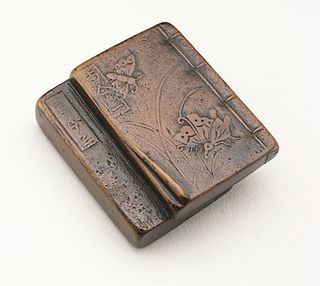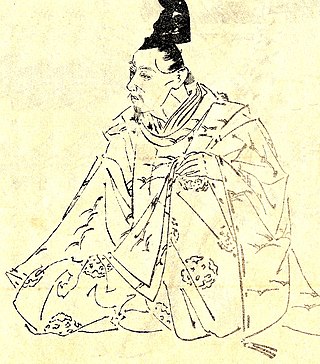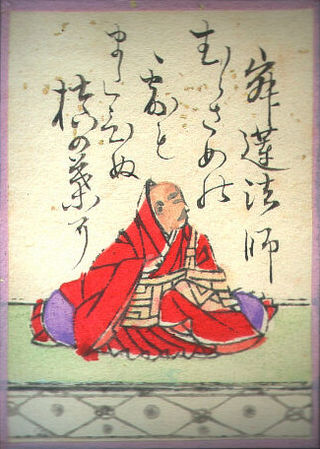Related Research Articles

Emperor Go-Toba was the 82nd emperor of Japan, according to the traditional order of succession. His reign spanned the years from 1183 through 1198.

The Kokin Wakashū, commonly abbreviated as Kokinshū (古今集), is an early anthology of the waka form of Japanese poetry, dating from the Heian period. An imperial anthology, it was conceived by Emperor Uda and published by order of his son Emperor Daigo in about 905. Its finished form dates to c. 920, though according to several historical accounts the last poem was added to the collection in 914.

Ki no Tsurayuki was a Japanese author, poet and court noble of the Heian period. He is best known as the principal compiler of the Kokin Wakashū, also writing its Japanese Preface, and as a possible author of the Tosa Diary, although this was published anonymously. He is well known for his waka poetry and is counted as one of the Thirty-six Poetry Immortals selected by Fujiwara no Kintō; his poetry was included also in the Hyakunin Isshu. As a courtier, he served as Governor of Tosa (930–935), Vice Governor of Kaga (917–923) and Vice Governor of Mino Province (918–923).
The Shin Kokin Wakashū, also known in abbreviated form as the Shin Kokinshū (新古今集) or even conversationally as the Shin Kokin, is the eighth imperial anthology of waka poetry compiled by the Japanese court, beginning with the Kokin Wakashū circa 905 and ending with the Shinshokukokin Wakashū circa 1439. The name can be literally translated as "New Collection of Ancient and Modern Poems" and bears an intentional resemblance to that of the first anthology. Together with the Man'yōshū and the Kokinshū, the Shin Kokinshū is widely considered to be one of the three most influential poetic anthologies in Japanese literary history. It was commissioned in 1201 by the retired emperor Go-Toba, who established a new Bureau of Poetry at his Nijō palace with eleven Fellows, headed by Fujiwara no Yoshitsune, for the purpose of conducting poetry contests and compiling the anthology. Despite its emphasis on contemporary poets, the Shin Kokinshū covered a broader range of poetic ages than the Kokinshū, including ancient poems that the editors of the first anthology had deliberately excluded. It was officially presented in 1205, on the 300th anniversary of the completion of the Kokinshū.

Saigyō Hōshi was a Japanese poet of the late Heian and early Kamakura period.

Japanese poetry is poetry typical of Japan, or written, spoken, or chanted in the Japanese language, which includes Old Japanese, Early Middle Japanese, Late Middle Japanese, and Modern Japanese, as well as poetry in Japan which was written in the Chinese language or ryūka from the Okinawa Islands: it is possible to make a more accurate distinction between Japanese poetry written in Japan or by Japanese people in other languages versus that written in the Japanese language by speaking of Japanese-language poetry. Much of the literary record of Japanese poetry begins when Japanese poets encountered Chinese poetry during the Tang dynasty. Under the influence of the Chinese poets of this era Japanese began to compose poetry in Chinese kanshi); and, as part of this tradition, poetry in Japan tended to be intimately associated with pictorial painting, partly because of the influence of Chinese arts, and the tradition of the use of ink and brush for both writing and drawing. It took several hundred years to digest the foreign impact and make it an integral part of Japanese culture and to merge this kanshi poetry into a Japanese language literary tradition, and then later to develop the diversity of unique poetic forms of native poetry, such as waka, haikai, and other more Japanese poetic specialties. For example, in the Tale of Genji both kanshi and waka are frequently mentioned. The history of Japanese poetry goes from an early semi-historical/mythological phase, through the early Old Japanese literature inclusions, just before the Nara period, the Nara period itself, the Heian period, the Kamakura period, and so on, up through the poetically important Edo period and modern times; however, the history of poetry often is different from socio-political history.

Hyakunin Isshu (百人一首) is a classical Japanese anthology of one hundred Japanese waka by one hundred poets. Hyakunin isshu can be translated to "one hundred people, one poem [each]"; it can also refer to the card game of uta-garuta, which uses a deck composed of cards based on the Hyakunin Isshu.

Fujiwara no Sadaie (藤原定家), better-known as Fujiwara no Teika, was a Japanese anthologist, calligrapher, literary critic, novelist, poet, and scribe of the late Heian and early Kamakura periods. His influence was enormous, and he is counted as among the greatest of Japanese poets, and perhaps the greatest master of the waka form – an ancient poetic form consisting of five lines with a total of 31 syllables.
The Shokukokin Wakashū is a Japanese imperial anthology of waka, a type of poetry in classical Japanese literature. It was finished in 1265 CE, six years after the Retired Emperor Go-Saga first ordered it in 1259. It was compiled by Fujiwara no Tameie with the aid of Fujiwara no Motoie, Fujiwara no Ieyoshi, Fujiwara no Yukiee, and Fujiwara no Mitsutoshi; like most Imperial anthologies, there is a Japanese and a Chinese Preface, but their authorship is obscure and essentially unknown. It consists of twenty volumes containing 1,925 poems.

Fujiwara no Ietaka was an early Kamakura period Japanese waka poet. Several of his poems are included in the Shin Kokin Wakashū. He was related by marriage to Jakuren, which made him strongly connected to the network of poets of the time. He was a pupil to Fujiwara no Shunzei.

Jakuren (寂蓮) (1139–1202) was a Japanese Buddhist priest and poet. He was adopted by the noted poet Fujiwara no Shunzei upon the death of Shunzei's younger brother. Shunzei originally intended for Sadanaga to be his heir; however, he subsequently had two male offspring of his own, and Sadanaga was forced to step aside in favor of Fujiwara no Sadaie. As was common practice at the time, he became a monk, and acquired the religious name of Jakuren. Taking Saigyo as his model, he traveled around the country, composing poems of his travels. He was well regarded in his time and frequently associated with Fujiwara no Teika. He was one of the six compilers of the eighth imperial waka anthology, the famous Shin Kokin Wakashū, and thirty-five of his poems were selected for the work. Before he died, he adopted Fujiwara no Ietaka, pupil to Shunzei. One of his poems was included in the famous poetry anthology Hyakunin Isshu.

Waka is a type of poetry in classical Japanese literature. Although waka in modern Japanese is written as 和歌, in the past it was also written as 倭歌, and a variant name is yamato-uta (大和歌).

Asukai Masatsune was a Japanese waka poet of the early Kamakura period. He was also an accomplished kemari player. and one of his poems was included in the Ogura Hyakunin Isshu.
The chokusen wakashū, also shortened to chokusenshū, were imperially-commissioned Japanese anthologies of waka poetry. They numbered 21 in total.
The Asukai family was a Japanese noble family.
References
- ↑ Cooper-Chen, Anne, and Miiko Kodama, Mass Communication in Japan, Blackwell Publishing, 1997, ISBN 978-0-8138-2710-0, retrieved via Google Books February 9, 2009